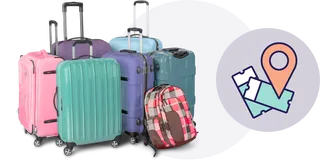
Seasonal Strategy: Take a Summer Vacation From Your Normal Marketing Campaigns
Like autumn leaves and spring allergies, consumer behavior changes with the seasons. That means brands must shift their marketing strategies, too. Brands that apply the same marketing tactics in winter as they do in the summer are missing opportunities—and misunderstanding their audience.
Summer Marketing Strategies
The sun is out, pools are open and plants are thriving, but what does the summer season mean for brands? Let’s take a look at several shifts that smart marketers need to take note of in their digital and experiential campaigns.

1. Your customers travel.
Let’s start with the most obvious: your audience may not be home (or even in their home country). That doesn’t mean that they won’t be interested in how your product or service supports their summer vacay, though. Even if it’s as simple as showing your product on a sandy beach or pre-recording your content in Q2 while wearing sun-bleached tank tops, be prepared to speak to your consumers’ changing whereabouts.

2. Mobile engagement increases.
When consumers are on the go in the summer, brands tend to see an increase in mobile engagement. Before the final day of June, conduct a comprehensive check of your digital presence to optimize your mobile compatibility. If your followers will be mostly on their phones, you have to be ready. You may also consider running a giveaway or campaign that leverages your audience’s summer plans.

3. Moods and perspectives change.
Whereas winter comes with seasonal affective disorder (SAD), the summer months tend to bring happiness due to increased sunlight and higher temperatures. So, you know, don’t ruin the mood! Use the warmer part of your color palette and shift focus to more positive messaging that aligns with your audience’s current state. If you’re a brand that dampens a sunny disposition, people will remember.

4. Spending goes down.
The downside to happier consumers is lower spending. Studies show people tend to whip out their wallets more when they’re sad than when they’re happier, a phenomenon called emotional spending. To make matters worse for brands, people have typically already spent their tax refund checks by the summer and are focused on experiences rather than products. To counteract this, either (a) leverage experiential marketing to show up where your customers are or (b) develop promotions that are too good to pass up.

5. Attention spans plummet.
Neuroscience research published in PNAS shows that people have a harder time concentrating in the summer than they do in the winter. When people are on the go, smiling in the sun and spending money on in-the-moment experiences rather than “things,” their attention is split more than usual. Brands can respond appropriately to this fact by decreasing the length of their videos, frontloading important information, writing shorter captions and shortening the path from first view to final action.

6. Back-to-school season looms.
Summer may have the longest day of the year, but it definitely feels like the shortest season when you're having the time of your life. Parents and guardians have no choice but to think about school supplies and their children's after-hours entertainment. If your product or service supports parents and guardians or has the potential to enhance the upcoming school year, don’t be shy about sharing how.
Several More Marketing Considerations
The recommendations above are widely applicable, but they’re not for everyone. If they don’t feel right for your brand, then they probably aren’t! There are two critical considerations that we’d be remiss not to mention:
1. Summer varies across hemispheres. If you're an international brand, you'll want to segment your audiences and tailor your campaigns to the right hemisphere. In the summer, your team in Los Angeles won't want to promote crop tops to your consumers in La Paz, or else you look like you have no geographical competence.
2. Summer is irrelevant to some brands. Ensure a summer slant in content aligns with your branding. You don't want to cause confusion with a "sun's out, buns out" message if you sell fur coats or if your core brand promise is that you work equally well in every season. Leverage summer marketing strategies at your discretion.
Support From a Sunny Marketing Partner
Elevate My Brand team members aren’t just sunny in our personality, we know how to shine when it comes to summer marketing strategies. Positivity and adaptability are crucial elements of our ethos—and we’re located in SoCal—so we might be the perfect fit for brands that need a partner to elevate their summer marketing campaigns.
If you’re ready to make the most of the hot months between spring and autumn, then let’s chat. The sooner we start our Discovery Phase process, the sooner you get to marketing elevation.
Cody H. Owens,
Content Director